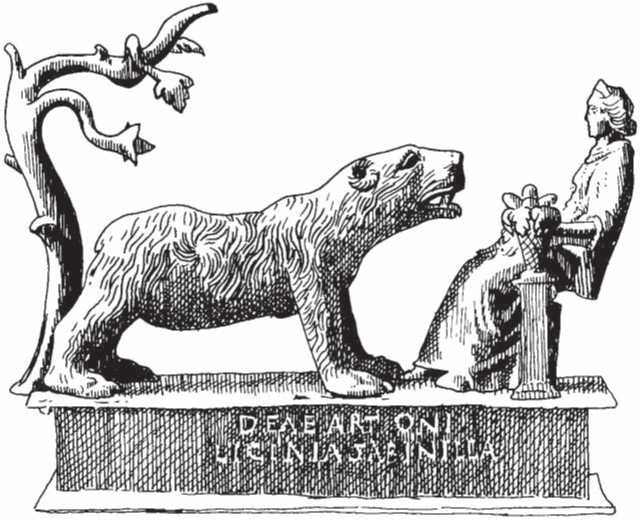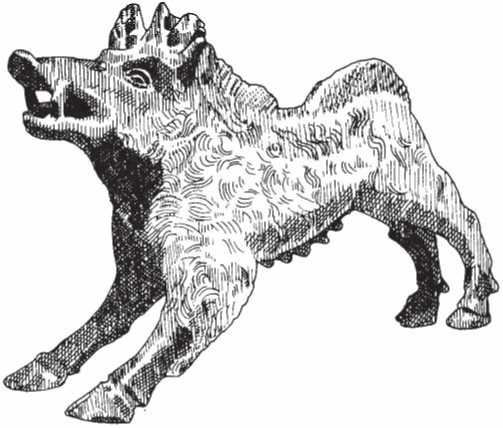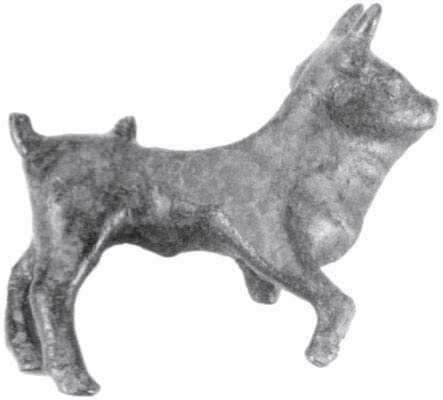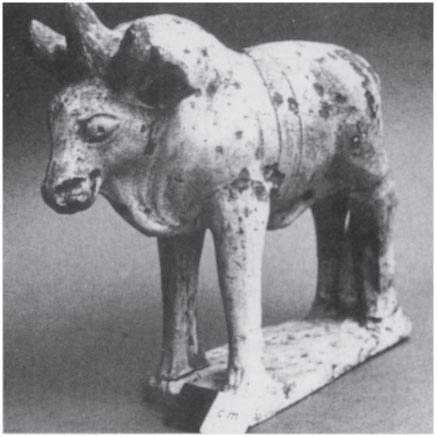Bears were least commonly represented: a group of little jet amulets in the form of bears comes from northern Britain and dates to the Romano-Celtic period. An example at York accompanies a burial of the fourth century AD; another was buried with the body of a child at Malton (Yorks.), but it is too small to have been a toy; a third was found at Bootle (Lancs.).69 There is evidence that particular divinities were occasionally perceived as having a close affinity with bears. Of these, the most important was the goddess Artio (figure 8.13), whose name means 'Bear', just as Epona's name refers directly to her equine associate. The

Figure 8.13 The bear-goddess Artio, on a Romano-Celtic bronze group from Muri, near Berne, Switzerland. Paul Jenkins.
Name indicates that the identities of goddess and bear are so close that they are almost one. Artio, whom we met briefly in the earlier discussion on hunting (chapter 3), was venerated in Switzerland: here a devotee commissioned a bronze group consisting of an image of the goddess and her bear, below which is a dedication to her. Artio sits with her attributes of fruit, and facing her is a large bear who leans forward as if either to threaten the goddess or to take the fruit. Behind the bear is a tree, perhaps representative of the wild forest he inhabits.70 Artio was the patron of bears, but she may also have protected the hunters or wayfarers who might encounter bears in the wood and be in danger from them. She was venerated outside Switzerland: among the Treveri of the Moselle, she was worshipped in the remote Bollendorf Valley, her name inscribed on the rocky sides of the defile.71 Artio may have had an ambivalent role, both as guardian of bears and as protector of humans against them. The goddess was perhaps perceived, not as a personified bear herself, but as a mediator between human and animal, a means whereby fear could be overcome and the bear-hunt be successful. But she would also ensure that the species survived and that each bear taken would be replaced. Interestingly, the divine patron of bears was not necessarily female: Mercury Artaios was venerated at Beaucroissant (Isere).
Boars
These creatures were above all symbols of warfare and aggression. Images of boars, dorsal ridge erect, decorated weapons and armour; boar-headed trumpets brayed fearsomely on the battlefield (chapter 4). Although there is little faunal evidence from Iron Age sites to suggest that boar-hunting provided much food for Celtic communities, the animal must have been hunted for sport and for the 'blooding' of young warriors in preparation for battle. War and hunting were closely associated in the Celtic mind: the north British god Cocidius was equated both with Mars, Roman god of war, and Silvanus, the Italian nature-god. He was depicted on stone carvings with spears and boars.72 Iconography indicates that boar-gods and goddesses were worshipped: the eponymous female divinity Arduinna was venerated by communities living in the Ardennes Forest. On a bronze statuette from the region,73 she is depicted as a huntress, wearing a short belted tunic and carrying a short knife. But she is riding-her boar companion and the weapon is not being used. We are perhaps witnessing a similar ambivalence in the attitude of Arduinna as is the case with Artio: she is a patroness of the animal, but her knife symbolizes her dominance and her ability to kill the boar if she so wishes. She is a protectress not only of the beast but also of its hunters. Another named boar - or pig-god was Mercury Moccus, worshipped among the Burgundian Lingones. The most important extant image of a boar-god comes from Euffigneix (Haute-Marne) and probably dates to the second or first century BC, before the Roman Conquest.74 The image consists of a stone block which has been carved, as if by someone more used to working in wood, into the shape of a man, wearing a heavy torc round his neck. A huge eye symbol adorns each side of the stone, perhaps to avert the Evil Eye or to make the image all-seeing and thus all-powerful.75 But most distinctive of all is the image of a boar which strides, bristles stressed, along the god's torso.76 The deity is identified by means of the boar symbol; there is a very close affinity between anthropomorphic and zoomorphic imagery here, and one can almost imagine a scene of transmogrification from animal to human form (or the reverse). The metamorphosis of boars was a common theme in both the Insular and the Welsh mythological traditions (chapter 7).
The aggression of the boar, symbolized by the erect spines along its back, is a striking characteristic not only of the Euffigneix boar but also of many boar statuettes. Many of these figurines date to the pre-Roman period, and are discussed in chapter 6. One clear example of this deliberate exaggeration of the bristles can be seen on the huge bronze boar from Neuvy-en-Sullias (Loiret), which dates to around the time of the Roman Conquest (figure 5.9). This nearly life-sized figure is one of many bronzes (including other boars, a horse, a stag and dancers) which were deliberately buried as a hoard, perhaps for safety, to protect such sacred images from looting by the Romans, near to a place on which a Romano-Celtic temple was later built.77 The same emphasis on the dorsal crest may be observed on a bronze plaque depicting a slain boar, from a shrine at Muntham Court, Sussex (figure 3.2),78 perhaps the centre of a hunting cult. The representation of boars on Iron Age coins (figure 3.4)79 all share the exaggerated symbolism of aggression and the semiological message of such representations is clear. Interestingly, it is the bristles rather than the boar's tusks which are chosen to reflect the animal's ferocious temperament. This is probably, at least in part, so that Celtic artists could have free rein to develop a naturalistic feature into something fantastic and ornamental.
Most curious of all boar images is a Gaulish figurine80 which shows all the combative, pugnacious characteristics natural to boars but which is given supernatural status by the addition of three horns (figure 8.14). This triple horn is something which is found on images of bulls (p. 222) but is much more strange when applied to an animal that is hornless in life. This figure must have been made by an artist or commissioned by a patron who was familiar with the relatively common triple-horned bull and who wished to enhance the potency of the boar-image by endowing it with a symbol which itself conveyed the concepts of destruction and fertility.

Figure 8.14 Bronze figurine of a triple-horned boar, Cahors, Lot, France.
Paul Jenkins.
Bulls
The essence of a bull is its power, virility and aggression: its fearsome horns and bellowing roar have endowed it with a clear but complex symbolism but, interestingly, the force of the animal was perceived by the Celts as entirely positive. Thus it was used as an image of fertility and beneficence, and if there were a belligerent aspect to the bull cult, the creature was seen as fighting on behalf of humankind against the negative forces of disease, barrenness and death. That the Celts viewed the sacred bull as a beneficial emblem is shown by the occurrence of bull names: one tribe, the Taurini, named themselves the 'bull tribe'; the town of Tarbes in southern Gaul was called 'bull town'; and in Galatia in Asia Minor, the name Deiotarus has been interpreted as meaning 'Divine Bull'.81
No one deity was particularly associated with the bull, but it seems to have fulfilled a sacred role in a number of cults. The fertility and regenerative aspects of the beast are indicated above all by its link with healing sanctuaries: images of bulls formed votive offerings at such curative shrines as Tremblois, Fontes Sequanae and Foret d'Halatte.82 The antlered god Cernunnos was associated with bulls: he was a god of nature and abundance (see pp. 231-4) and the bull enhanced his role as a beneficent provider. On a stone at Saintes, Cernunnos sits on a throne supported by bulls' heads,83 and on a relief at Reims (figure 8.21), the god sits pouring grain out of a bag, which is consumed by a stag and a bull standing beneath him.84 Here the two most potent zoomorphic images of virility are present: the stag represents the wild woodland and the bull the domestication of farm and field.
The image of the bull as a bringer of abundance may account for the presence of bull symbols on such objects as buckets and firedogs. Cattle were crucial to the Celtic economy (chapter 2) and this may have led to an association between the image and plenty. Bucket-escutcheons or handle-mounts in the form of bull heads are common on both Iron Age and Romano-Celtic sites in Britain and on the Continent: the great cauldrons from Bra (figure 2.6) and Rynkeby in Denmark are decorated with bull heads (chapter 6). There is a particularly interesting North Welsh group of bull bucket-ornaments, represented by examples from the Little Orme, Dinorben and Welshpool, with stylized faces, prominent snouts and jutting horns (figures 2.5, 7.14).85 Such emblems may have been attached to vessels, not simply for decoration but to fulfil some magico-symbolic purpose, probably connected with the contents of the vessel.86 Similar symbolism may have pertained to the bull heads on iron firedogs, such as those from Barton (Cambs.), Baldock (Herts.) and Capel Garmon in North Wales (figures 2.23, 5.6, 5.13). These firedogs were used for containing fires within the hearth space, and were thus linked with

Figure 8.15 Bronze bull, once triple-horned, Cirencester, Gloucestershire.
Betty Naggar.
Culinary activities - the roasting or boiling of meat. The Capel Garmon firedog dates to the first century BC or first century AD, and is arguably the most ornate and beautifully wrought piece of ironwork in existence. The interesting feature of the animal-head terminals is that, although they bear extravagant horns, the heads themselves are more reminiscent of horses than bulls, and they have manes. This last detail may not be significant since, in the 'Tain', the two great mythical Irish bulls are described as maned.87 However, it may be that the Capel Garmon firedog was made with deliberately ambiguous zoomorphic symbolism, whereby elements of both horse and bull (both prestigious creatures for the Celts) were purposely incorporated in the imagery.
The possible ambiguity of the Capel Garmon piece is present in a different form on a series of curious bucket-mounts, which contain a composite element: at Thealby (Lincs.), the mount consists of a bull's head surmounted by that of an eagle; on an even more complex example from the river Ribble in Lancashire, the heads of a bull, an eagle and a man are combined.88 Some kind of mythological or cult-story must be reflected by these curious images: it is tempting to link them with episodes in the early literature. In the 'Tain', there is an interchange between the great Brown Bull of Ulster and the raven-formed battle-goddess, the Morrigan.89
One category of bull image which is both distinctive and enigmatic is the triple-horned bull, of which there are many examples, notably in north-east Gaul, with a mere scattering of statuettes from Britain (figure
8.16).90 The images are mainly in the form of small figurines of bronze, but clay ones are known and occasionally they occur in stone. Usually, the triple-horned bull is not associated with other cult imagery, but there are exceptions: at Beire-le-Chatel in Burgundy91 a curative sanctuary contained several cult objects including images of a Celtic Apollo and a goddess of music, Ianuaria, as well as groups of stone doves. Here were found several stone images of the three-horned bull. The other important association is at Willingham Fen (Cambs.) where a bronze mace or sceptre was found, possibly associated with a shrine. On the mace are depicted a god with a wheel, a dolphin, eagle and the head of a triplehorned bull.92 The wheel and the eagle are indicative of celestial symbolism and we know that in classical myth and religion, the sky-god Jupiter was closely linked with the bull. The triple horn is not easy to explain: triplication was a common form of image-making among the Celts,93 which appears to have combined concepts of intensification and a deliberate veering away from naturalism. The bull itself is a power symbol, and its horns exemplified that power. The tripling of the horn at one and the same time augmented that power, rendered the image out of the ordinary (and therefore perhaps divine) and introduced the magical symbolism of the number three which was so dear to the Celtic

Figure 8.16 Clay three-horned bull, first century AD, from a child's grave at Colchester, Essex. Miranda Green.
Spirit. So whether the triple-horned image occurred in company with a healing deity or the lord of the sky, it served the same purpose of increasing potency both for itself and for its cult associates.
The great bull image of Tarvostrigaranus has been discussed earlier when the theme of cranes was explored. The bull appears on two monuments, in Paris and Trier:94 on the Paris stone (figure 8.11) a huge, heavily muscled bull stands before a willow, three marsh-birds on his back and head; above him is the dedication. Again the bull is associated with triplism, not in the horns but in the imagery of the three birds. The precise significance of the bull in this context is obscure, but the general imagery of willow, birds, bull and woodcutter (who hacks at the tree in both monuments) may represent a cyclical myth of the death of winter and the renewal of spring.95 So the bull may once more be present in his virile role as promoter of fertility. The link between triplism and bulls, seen in the third horn and the three cranes, is also present on the pre-Roman Gundestrup Cauldron:96 the iconography with which the silver plates of this cult vessel are decorated includes a great deal of bull symbolism. The animal here plays an essentially sacrificial role: on the baseplate a bull sinks dying to the ground under the attack of hunters and dogs (figure 5.1); on one of the side panels, the bull is again sacrificed to the knives of men, but here the creature is in triple form (figure 5.3).




 World History
World History









